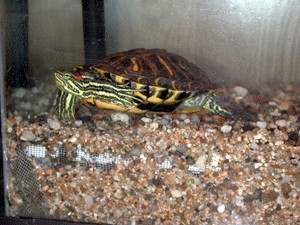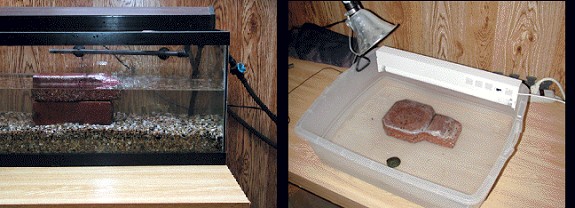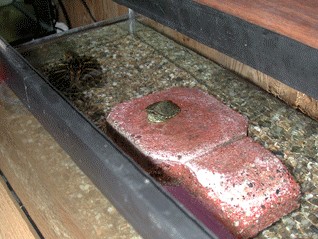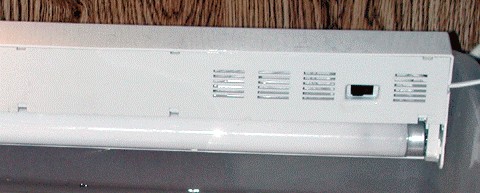Many aquarium keepers have been exposed to water turtles at their local pet store and the idea of adding one to
our aquarium comes to mind. Initially it makes sense since turtles occupy the same aquatic environment as
many of our freshwater fish and the image of a cute little turtle swimming among the plants and rocks would
add color and animation to our display tank. In reality though, turtles occupy a different niche in the streams
and ponds and share very little time or space with the fish that comprise the freshwater aquarium hobby. They
require different heat, light, food and even water levels, so in fact it turns out that their ideal environment is
exactly what our fish do NOT need. We know this, so we resist adding them to our collection.
Still ... each time we're at the store ... there they are, staring at us from their log, silently bending us to their will
until more than a few of us crumble and walk up to the tank to begin picking out our newest acquisition and
silently rehearsing the excuse to our wives, girlfriends, boyfriends, husbands or parents as to HOW this makes
sense and WHY we had no real choice. In another article, I will detail how I explained to my parents many
years ago that I have no choice but to purchase a pair of Florida Alligators.
The Care and Keeping of the Red Eared Slider
Pseudemys scripta elegans
The Red Eared Slider is typical of a large array of water turtles that share enough common characteristics in
captivity that they can all be grouped together for purposes of care and keeping. This family includes Sliders,
Cooters, Map & Sawback Turtles and Chicken Turtles. All these members of the Emydid family (no need to
memorize that) split most of their time between swimming and basking. This means that they need a water area
large enough to swim and explore and a land area just large enough to haul out and bask. Given a pond with
shoreline and floating logs, some animals will climb the logs and avoid the shore entirely. Their dietary needs
are simple and easy to supply, as are their heat requirements. This leaves the primary difference between a
well-kept turtle and a poorly kept turtle to be the enclosure and the water within.
Red Eared Sliders are what they call sexually dimorphic (no need to memorize THAT term either), which
simply means that there are outside differences between males and females. Females grow larger than males,
but then since an older male can be larger than a younger female that's no easy way to tell. Males have thicker
tails than females, but again that's when you have two turtles of equal age and size to compare. There are two
things to keep in mind: Turtles like most reptiles, mature with size, not age and when a slider reaches about
four inches in length (placing a flat ruler over his shell and measuring the length of the shell from front to back)
the males develop longer nails on their front claws. And I don't mean a little bit longer, I mean a LOT longer.
Long enough for the average person to think they need to be trimmed (they don't). The other thing to keep in
mind is -- that it doesn't matter. Males get along with other males as well as they get along with females, and
sliders of both sexes and pretty much all different sizes, if properly maintained, get along just fine with each
other.


Note the elongated front claws on this young male.
Figure 1
Section 1 - Indoor Enclosures
When considering keeping your Slider indoors there are many factors to consider. Where you plan to keep it
and how you plan to view it are important. In my experience, pets that are kept for viewing tend to be more
well kept that ones that are placed 'out of the way.' Now with that point made, I will advise you from the
standpoint of the turtle and for him that's a simple trade off: Space versus cleanliness. As a free-swimming
water turtle he appreciates as much space and as much water as you can spare, but at the same time the
condition of the water in terms of clean and clear are also a major factor.
Size matters, but not always the way you think
I've raised hatchling turtles from birth (1/2 inch in size) to two years (3 inches) in a 20 gallon aquarium filled to
half with an under gravel filter, normal small gravel and a 100 gph power filter. I rigged the output of the
power filter to go down into the tube of the under gravel filter in order to push clean water from the pump/filter
UP through the plates and gravel and with this, every month I had to siphon out all the gravel, wash it and
replace it. Large turtles require larger tanks and aside from the how it looks, many keepers have been
successful with big plastic rectangular tubs available at any home supply store.

This is a normal 20 gallon aquarium with a matching
fluorescent hood. It has an under gravel filter where the
up flow tube is connected to the intake of an external
power filter and the return water to a spray bar.
With a quick change of tubes, the pickup can be from
the main tank water and the clean outflow to the under
gravel filter, causing clean water to be pushed upward
to help cleanse the gravel bed.
This setup can cost over $350
This is a 30 quart plastic storage container, clamp lamp
and an "under counter" light fixture, all from a local home
improvement center.
This setup cost slightly less than $28
Figure 2
What is important to note -- is that BOTH these setups serve the needs of the turtle
The biological filtration that we depend on in the aquarium hobby is wholly unsuitable for breaking down the
waste products of even one turtle, so we must rely either on a highly efficient mechanical filter, regular water
vacuuming or the complete break down & scrubbing of the enclosure -- or most likely a combination of all
three. Now this is the first major difference from the aquarium hobby, where bigger and more water are almost
always better: A smaller enclosure that is easier for you to drain, clean and refill will be better for the
turtle in the long run than a larger enclosure that is harder to clean and where the quest for water quality
becomes a losing battle. So while wide and deep water is best ... but don't over stretch yourself -- live by the
rule "No bigger than I can clean" and your turtle will thank you.
Turtles seem to appreciate deeper water for swimming and their antics in deep water are more fun for us to
watch so you might think that this is once again a trade off between cleanliness and viewing pleasure ... but
there is one additional factor to consider: The water is where the turtle goes to cool off, so there should be
enough water that it's temperature doesn't climb or dip dramatically during the day or night. Simply put -- the
deeper the water, the more likely that water will remain cool during the day and retain some heat at night.
Everyone Out of the Pool
Hauling out of the water to dry off and regulate temperature is an important requirement and one that we must
provide after some very careful considerations. The good news is that they don't need very much room as long
as it is easy to access. As stated earlier, many animals won't come on "shore" at all except to lay eggs or
migrate to another lake or pond and seem to actually prefer a floating log to actual land. A turtle isn't
particularly agile or fast on land so it makes sense that a log offers the space needed, yet only a single push of a
leg and they're in the safety of the water once again. However, knowing that doesn't necessarily make our job
any easier. Actual wooden logs tend to leech colors and dyes into the water which make our cleaning just that
much harder --and-- as an added bonus, they get waterlogged and lose their buoyancy a lot sooner than you can
imagine, so indoors, I've found it best to use a "shelf" arrangement where I make a platform, usually of some
form of shale or stone or whatever I can rummage from a local building supply store or stone yard and I support
that with common bricks. Bricks supporting a piece of wooden plank such as Pine will work, too. At times,
I've simply arranged rocks and/or bricks to make a "pile." Turtles are simply not very concerned - as long as it
gets them out of the water. Let cleanliness (ease of disassembly for cleaning) and aesthetics be your guide --
with two additional considerations. The first is that turtles are AMAZING climbers. Many a turtle keeper has
been astounded to see his turtle sitting on the floor outside it's enclosure with {what seems like} no possible

way that it could have climbed out. The second concern and one equally feared -- is that somehow the turtle
can get caught UNDER the basking area somehow and drown. Please give both of these possibilities serious
consideration in your planning. Pet Stores have recently begun to sell some hang-on "turtle shelves" that
consider both these issues. Even if you don't purchase one, looking at it might give you some hints as to how to
proceed.
Generally, turtles will take advantage of anywhere to haul out
and don't mind sharing. Many times they'll simply climb over
and pile on each other until the topple back into the water.
Figure 3
In the Heat of the Light
Basking is an important ... um ... activity for a Slider and they can spend a great part of their day doing very
little except sprawling out on some bit of dry land or log and arranging themselves in some certain way in order
to get warm. Moving between the heat of the light and the cool of the water is their method of regulating their
temperature, so the next order of business is to provide heat. Unless you live in a northern state and plan to
house your turtle in the garage, it is not necessary to heat the water. Any temperature that you would find
comfortable for yourself will allow a water temperature suitable for the turtle. Beyond that, any heater placed in
the Slider's enclosure is just asking for him to break it, so given both those situations, forget heating the water
and concentrate on heating his basking area.
Normally, a regular 60 or 100-watt bulb positioned over his basking area is enough. Ideally, a basking area can
be long enough that part of it is directly under the light and reaches around 95 degrees (F) while another part is
not quite so warm (perhaps 85F). If this isn't possible, around 90F is an acceptable compromise. A small
digital thermometer from Radio Shack or similar store can help you position the lamp, but failing that a rule of
thumb is that when you place your hand under the lamp you should immediately feel the warmth ... BUT you
should be able to hold your hand there for at least three minutes without feeling uncomfortable.



A simple digital thermometer from a local pet store is usually
under $10
Figure 4
UVA and UVB are both important parts of the light spectrum not readily available in a standard light bulb and
the "Reptile Bulbs" sold in pet stores that fit in a screw-in socket rarely generate the heat needed. The best
compromise is an inexpensive 18 inch fluorescent light fixture from a building supply store (you went there for
the hooded socket over the basking area, the power strip to plug these things in and the timer you'll use to turn
this all off and on -- so just add this and you're done shopping there!) along with a fluorescent reptile bulb
available online or at your local pet store. The most amazing thing about these lights is how fast the beneficial
wavelengths fall off as you get further away. Most bulbs will have documentation and it is not unusual to find
that at 12 inches away, you lose 50% of the benefit of the light. Again, that only tells us not to place the light
24 inches above the basking area. A foot above is just fine.
UV (ultraviolet) wavelengths are delicate. The bulb should be close to the basking area but also
-- and this is important --
Any lens or glass between the actual bulb and the basking area defeats the purpose of the bulb
Figure 5
Let the Sun Shine In - just a little
Sunshine is a great thing. Fresh & natural ... nature's best. Every turtle can benefit from natural sunshine as it
promotes healthy metabolism, vitamin utilization and all sorts of other good things. The UV rays of natural
sunshine are beneficial in every way, but it also adds some risks that we must take into account. First, as
sunlight passes through glass it loses it's health-promoting values since the UV rays are the first part of the
spectrum to be filtered out. At the same time, sunlight coming through glass (window glass, aquarium glass)
increases it's HEAT potential by a great amount, making a confined space a perfect place to accidentally over
heat or possibly even kill a turtle. Having water that they can slide into to cool down is good, but remember
the sun heats the water too! Unless you have enough water to guarantee that it will remain cool in the direct
sunlight, it's best to provide direct shade for the turtles to move in and out of. One last thing most people don't
know: Screens, such as window screen and mosquito screens also filter out a small portion of the very UV
spectrum that we want them to get. So in general, direct sunshine offers benefits as well as dangers and these
possible problems must be taken into account when setting the turtles outside, even for "just a little bit."
Krill and Chopped Goldfish -- it's not what's for dinner.
Food is by far the easiest element to deal with. This is an area where our fish and our turtles do enjoy the same
things -- nature provides both their aquatic environments with the same foods and treats. I have raised
hatchling turtles of just about every genera from Sliders to Snappers all the way to full sized breeding adults on
a single staple diet:
Koi Pellets! Simple. Balanced. Inexpensive. Easy to store. I use the Kay-Tee brand available at every pet &
fish store in my area and I store it in Tupperware containers and I feed my turtles all they can eat in five minutes
... three times a week. They would gladly eat more. They'd eat that much every day if I fed them, but all that
would do is give me fat turtles with a whole host of health problems that come from being over-fed and under
active. Don't give in to your feelings that they are still hungry so therefore they must be "unhappy" -- that's a
human emotion. They don't have to go to school, or work. They don't have to pay taxes, buy groceries or take
care of their children -- what's to make them unhappy? Let them be a little hungry -- it's healthy for them (and
for us, too!).
After the basic diet come treats. I prefer night crawlers (worms). Wait, that doesn't sound right. THEY prefer
worms! About once every six weeks, I'll buy a small container of night crawlers from my local pet store and
feed one or two. Again, only what they can eat in about five minutes. Maybe repeat the same thing next day
and then toss the remaining night crawlers into the garden. The reason I do this is because worms need to be
refrigerated to be kept much longer than overnight and not everyone has the ability to do that. Let me put that
another way: You need a WHOLE LOT of permission before you put worms in the refrigerator. If you come
across snails in your garden they can also make a fine treat, but you have to make sure and know for certain that
the snails haven't been exposed to any form of snail pellets or snail bait.
There are many other things you can try that all have their down sides: Live goldfish and guppies will work --
except that the turtles won't eat all of them (they're not agile enough to catch most live fish) and you'll end up
attached to the fish and then they present problems during cleaning. Chopped fish and Krill are OK, but they
foul the water very quickly and simply are not necessary. At the bottom line, if you fed Koi Pellets and nothing
else your turtles will grow, thrive, and not miss anything else.
The basic recipe:
o
Tank or enclosure
o
Mechanical filter
o
Basking area
o
Heat lamp
o
UV lamp
o
Timer & Power strip
o
Koi pellets
Just add turtle and you have a fun, interesting and low maintenance pet!
That's Part 1 - indoor keeping.
Outdoor keeping, breeding, ailments and the differences with other turtles to follow in Part 2.